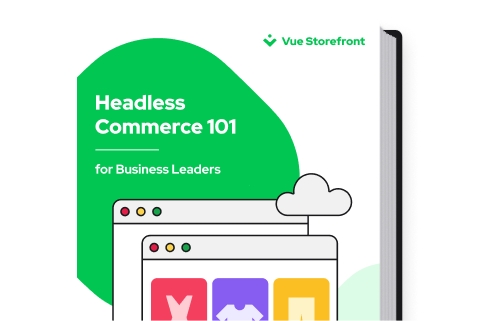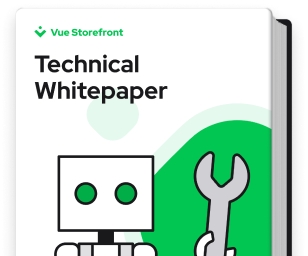Explore by Category:
Headless Commerce
What is a Headless Application?
The headless concept has been on the rise for several years now, uniting both technical and business teams at one table. Most of all, it promises to deliver a solution to the constraints posed by traditional all-in-one software, which are powerful blockers to the development and marketing teams alike.
Therefore, if you’ve been dealing with sluggish web performance or poor flexibility, it might be the right time to explore headless applications.
What is headless, how does a headless application work and what do you need to know about this new approach to building software? This article covers it all.
What is a headless application?
A headless application is a software program which runs without an inbuilt graphical user interface (GUI) and provides a specific functionality to your application or website. It uses API to connect to the frontend solution and send the data to be presented on the frontend layer.
A headless application meaning covers a software type, which is not a fully independent app, but a solution which works as a part of a composable architecture . Usually focused on a specific task, it provides a single functionality without imposing its UI, which makes it more flexible than standard applications.
The role of API in headless apps
In a headless system, API connects the frontend and backend layer of the application. A frontend solution like Alokai works as an API client or a “headless client”, fetching data to be displayed on the presentation layer.
Read more about API in headless commerce .
Benefits of headless apps
Fast development
In case of headless websites headless applications help to significantly speed up development time. You don’t need to take care of the frontend layer of the system or other additional solutions which can be easily added with the use of API. With headless software in place the development takes less time, resources and money.
Another advantage of headless applications is that they can be easily run on servers. Since they don’t require multiple complex libraries or software infrastructure, and can be easily monitored, maintained and automated, it saves both development time and money.
High flexibility
Consumer habits are rapidly and constantly changing, making the market incredibly competitive. To avoid losing customer loyalty, businesses must be agile and flexible in implementing modern solutions to meet new trends and customer expectations in near real-time. The tightly connected elements of monolithic systems make it challenging to provide a superb customer experience because the front- and backend are coupled.
This lack of flexibility means that developers must interfere with the underlying database code when changing the frontend and adjusting it to new marketing goals or brand identity. It can be risky to move to modern frameworks with better web performance or change the UI (user interface). Any updates to monolithic software need thorough testing to prevent any calamities from bringing down the entire system.
This is precisely why headless apps are such a hot topic today. It solves all of the challenges listed above. Testing new services or adding new features typically does not threaten to disrupt the entire system. Marketers now have the freedom to make swift and necessary changes to the frontend without help from developers.
Composability and freedom to choose best-of-breed solutions
While one-size-fits-all monolithic software solutions were reasonable a few years ago, businesses faced the need to scale more quickly and efficiently. As the default monolithic features turned out to obstruct and slow down corporate growth, one-stop-shop software architectures became a severe disadvantage.
User expectations for new features, the best UX, and lightning-fast page loading created a course correction for businesses, causing them to shift their focus to choosing from a selection of the finest interoperable solutions on the market.
And this is when headless apps come into play. The API-first strategy allows businesses to design and construct a tech stack with their choice of best-of-breed CMS, payment providers, search, loyalty, rewards programs, and more.
Fast web performance
Headless technology provides performance-driven architecture with a heavy emphasis on SEO (mobile and desktop). When it comes to application speed, time indeed equals money. Slow, monolithic apps lose users to quick headless applications.
Headless apps are ideal for establishing omnichannel campaigns. This is because each frontend channel can be linked to the backend independently. Headless systems are built for scalability, as they may be adjusted progressively to handle increased demand as needed.
Securing a solid foundation for future development necessitates satisfying these consumer expectations with flexibility at both the technical and organizational levels. It can be not easy, particularly in monolithic systems where updates and modifications must be managed separately for each device. This possible stumbling block is removed by using a headless method.
Great developer experience
As a modern solution releasing the constraints of legacy software, headless concept appeals to both business and technical teams. Great developer experience results mainly from the fact that headless apps ensure high levels of flexibility and reduce the effort to build apps, focusing on innovation instead of repetitive manual tasks.
The ease to compose a system of best-of-breed solutions, the use of modern frameworks, speed of development – it all adds up to a great developer experience.
Headless software examples
Below you can find a list of main headless app examples. As the industry grows and gains popularity due to its efficiency, more headless vendors are joining this accelerating market daily.
Headless CMS
Headless CMS (Content Management System) allows the storage and organization of content separately from the website’s presentation layer. It is a digital repository for blog posts, images, videos and other content operating as a backend system for content management.
Headless commerce platform
Headless commerce platform is a modern commerce engine, which works separately from the frontend layer. The communication between the two parts is fast as it happens via API.
Headless commerce platforms use APIs to connect with additional headless applications like headless CMS, headless payment, search or recommendation solutions. As a result, each implementation proceeds faster, and the whole system runs more responsively.
The approach of building an eCommerce tech stack with complete headless architecture is widely known as headless commerce .
Headless payment
Any preferred API-hosted payment gateway can be integrated with the headless stack and operate as a headless app to support the checkout & payment process through integrations with a payment provider.
Headless search solution
Headless applications covering the search and discovery features efficiently deliver rich product and content-based experiences on every device and channel.
Headless browser
Headless browsers work just like a regular search engine accessing the websites in search for information, but do not display them to the user. All operations happen in the backend. As an example, you can launch Chrome in a headless mode, using Python for headless programming.
Frontend as a Service: Frontend solution for headless applications
Frontend as a Service (FEaaS) is a frontend solution that speeds up custom frontend development by providing pre-built and pre-optimized building blocks ready for customization. FEaaS allows you to build and customize an engaging, unique, and highly performant frontends that combine and present data from multiple headless applications with just one tool, in a fraction of the time and cost.
This approach cuts development time and saves investment, supercharging digital customer experiences and boosting your business performance from day one.
Since all the core elements for frontend development are already available to developers, they can create a performant and mobile-first frontend layer in significantly less time and focus on customizing pre-built components instead of building from scratch.
Download the technical whitepaper to learn more about Frontend as a Service
Share:
Share:
Frequently asked questions
Ready to dive in? Schedule a demo
Get a live, personalised demo with one of our awesome product specialists.




















